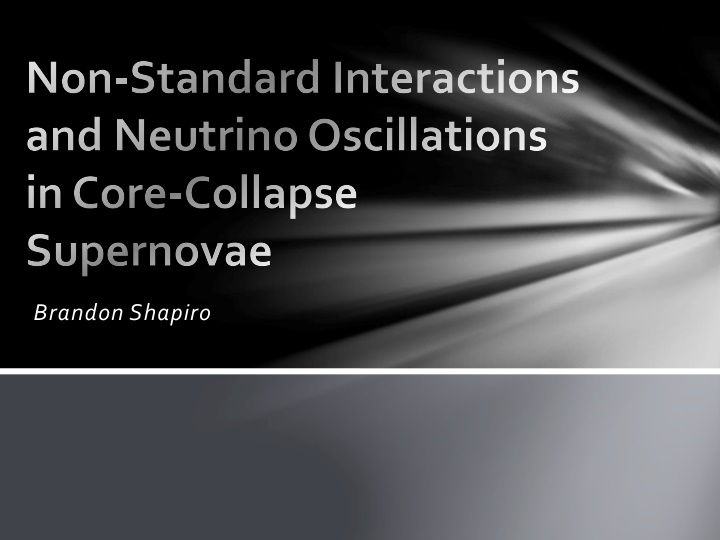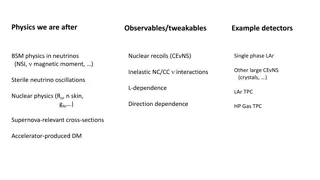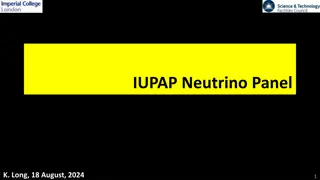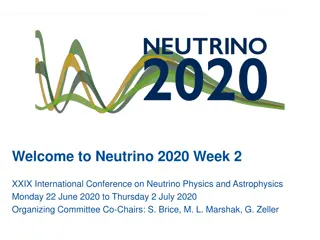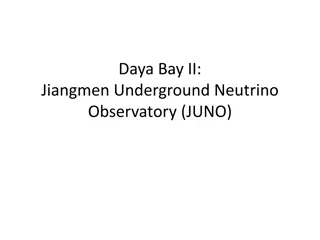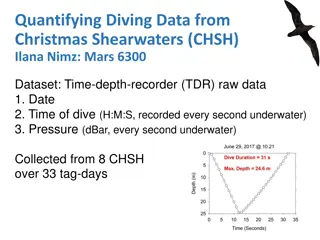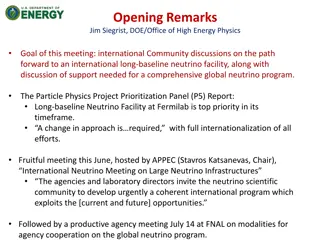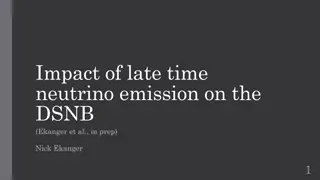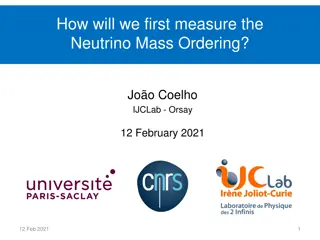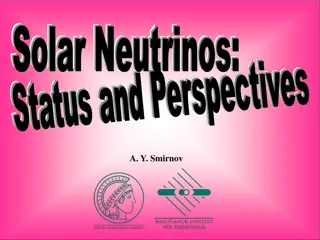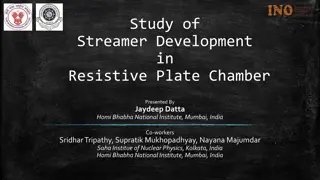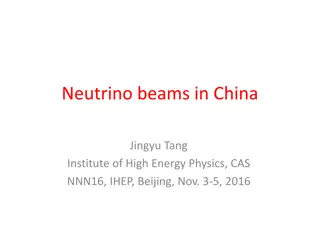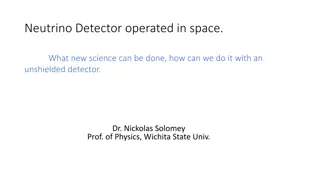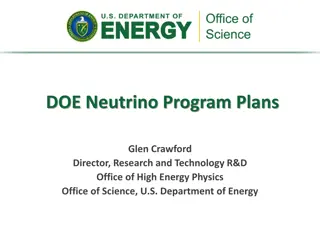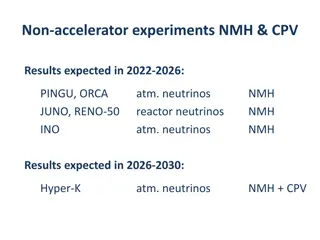Diving into Neutrino Interactions and Oscillations
Exploring the intricate relationship between non-standard interactions and neutrino oscillations in core-collapse supernovae reveals the crucial role played by neutrinos. These elusive particles, with their unique ability to pass through matter, hold the key to understanding the dynamics of supernovae explosions and flavor oscillations. The background of core-collapse supernovae and neutrinos unfolds the fascinating journey from hydrogen fusion to iron core formation. Delve into the world of neutrinos, their flavors, and the intriguing phenomenon of flavor oscillations that shed light on the mass states of neutrinos. Unravel the mysteries of neutrino physics and its implications in astrophysics.
Download Presentation

Please find below an Image/Link to download the presentation.
The content on the website is provided AS IS for your information and personal use only. It may not be sold, licensed, or shared on other websites without obtaining consent from the author.If you encounter any issues during the download, it is possible that the publisher has removed the file from their server.
You are allowed to download the files provided on this website for personal or commercial use, subject to the condition that they are used lawfully. All files are the property of their respective owners.
The content on the website is provided AS IS for your information and personal use only. It may not be sold, licensed, or shared on other websites without obtaining consent from the author.
E N D
Presentation Transcript
Non-Standard Interactions and Neutrino Oscillations in Core-Collapse Supernovae Brandon Shapiro
Background: Core-Collapse Supernovae In the core or stars, hydrogen atoms are fused into helium When all of the hydrogen has been used up, the remaining helium contracts and begins fusing into heavier elements In stars of 8 to about 40 solar masses, this process eventually builds up a core of iron and nickel When this core exceeds the Chandrasekhar limit of 1.4 solar masses, gravity causes it to collapse inward When the core reaches the maximum nucleon density, it rebounds outward as a shock wave, forming the explosion As the core collapses, it emits large quantities of neutrinos
Background: Neutrinos Neutrinos ( ) are electrically neutral fundamental particles, first imagined in 1930 to conserve energy and momentum in beta decay They interact with other particles only via the short ranged weak nuclear force, so neutrinos can pass right through most normal matter Therefore, they are very difficult to detect; neutrino detectors today are the size of large buildings There are (at least) 3 neutrino flavors, e, , & , each interacting slightly differently with its corresponding lepton (electron, muon, tau)
Background: Flavor Oscillation In the late 1960s, an experiment to detect solar neutrinos found only a third of the expected e-flavor neutrinos coming from the sun This deficit was explained by the theory that a neutrino observed to have one flavor can later be observed to have a different flavor The probabilities of a neutrino having each of the three flavors oscillate over time (always totaling 1 of course) While neutrinos were originally thought to be massless, this implies that there are 3 different neutrino mass states, which are not equivalent to the 3 flavor states
Background: Flavor Oscillation The probability of a neutrino being observed to have a given flavor obeys the Schr dinger Equation: ?(?) ?(?) ?(?) ? Here the vector depends on the initial flavor conditions ?(?) ?(?) ?(?) ? ? = ? ?? 2= ?( ?) 2+ ? 2+ ? 2= 1 ? can alternatively be written as = ? 0 ??? 2= ?( ? ?) 1 0 0 0 0 1 0 0 1 0= , ,
Supernova Neutrino Oscillation In a supernova, it is more relevant to keep track of a neutrino s radial position than the time ? ?? Using natural units removes ? and from the equation When the ? matrix representation of is used in the Schr dinger Equation, 0cancels out as a constant, giving the equation as: ??? ??= ??
Vacuum Oscillation ? is called the Hamiltonian, in this case a 3 3 matrix ? = ???????+ ???????+ ????? ??????????? ???????is the vacuum Hamiltonian, given by ???????= ??? ? is a diagonal matrix of the energies of each mass state The mass states are rotated by ?, the 3-flavor mixing matrix, into the basis of flavor probabilities ???????represents the instability of the observable flavor and mass states With no other matter or neutrinos present, ? = ???????
The Matter Potential ???????is the matter potential (or MSW potential) It accounts for the effect of matter on flavor evolution The potential for flavor depends only on the relative amounts of each lepton, so the terms for muon and tau particles cancel out 2????(?) 0 0 0 0 0 0 0 0 ???????= ??is the number density of electrons, decreasing as the neutrino propagates further out from the core ??is the Fermi coupling constant
The Self-Interaction Potential ????? ???????????represents the potential for flavor change from other neutrinos propagating through the supernova Using a simplifying single-angle approximation: ????? ??????????? ??0? ?? ? ?0 ? ?? ?0is a matrix representing the initial neutrino densities, which are then modified by S to account for flavor change The integrals are with respect to different energy levels The dependence of ????? ???????????on ? makes this a nonlinear problem (and a complicated one at that)
Non-Standard Interactions (NSI) There is significant evidence that the Standard Model of particle physics is incomplete For example, phenomena such as dark matter and dark energy have yet to be explained There could possibly be particle interactions outside the Standard Model that affect neutrino oscillations If a relationship between the strength of NSI and flavor probabilities of supernova neutrinos were determined, data from modern neutrino detectors could be used to measure the strength of NSI from the next galactic supernova
Neutrino Oscillations with NSI NSI with matter is incorporated into the equation as a 3 3 complex matrix called ? added to the Hamiltonian ? = ???????+ ???????+ 2????? ? + ????? ??????????? The goal is to find how the solution for ? relates to ? Such a relationship could normally be found easily using perturbation analysis, perturbing the solution to the equation without NSI with 2????? ? However, ????? ???????????makes the problem nonlinear, so adding ? affects ? which then affects ????? ???????????, making perturbation analysis much more difficult
Simulated Results ?( ? ?) vs Distance at 20 MeV for multiple values of ???
Simulated Results Final ?( ? ?) vs ???
Simplified Case NSI showed a significant but difficult to measure effect A supernova density profile and vast energy spectrum is too complicated a problem to notice a pattern Constant Density, Single Energy Results
Simplified Case Results for varied values of ???all looked similar, but with different frequencies Frequency vs Distance for multiple values of ???
